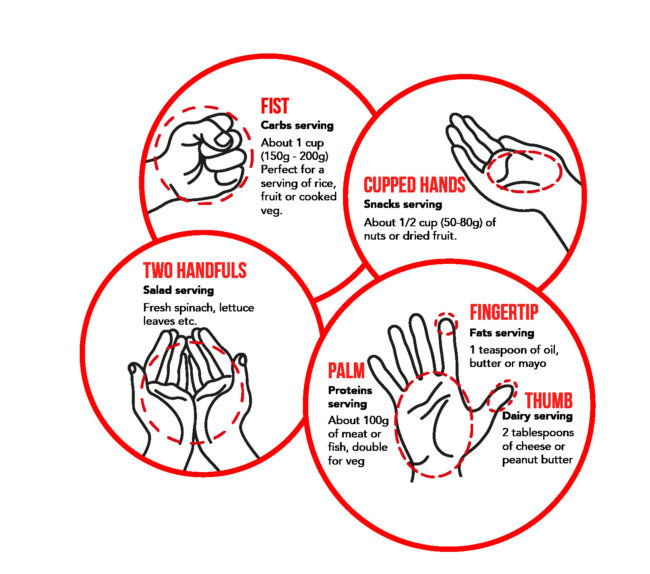Planning a nutritious, balanced diet is one thing, but consuming the recommended amount of food is another.
What is a portion and why does it matter?
How much food you consume will affect your calorie intake and therefore weight loss or gain. The two words used to describe amounts of food are:
- Serving size or serving is the amount of food listed on a food label. It’s generally a pretty good indicator of a recommended amount to consume.
- Portion size is the amount of a given food you choose to eat. This can be more, less or the same as a serving.
The government recommends a daily calorie intake of 2,500 calories for men to maintain weight. We should note though that this is generalised and will vary according to the individual. A more accurate reflection of your personal energy requirements can come from your Total Daily Energy Expenditure (TDEE). This considers your height, weight, age and activity level to calculate your own personal recommendation. Illness and taking certain medicines can also change your energy needs.
Making positive changes to your diet, like prioritising fruit and vegetables, will mean you boost the fibre, vitamins and minerals in your diet, and it can reduce the overall number of calories you consume. But it can be easy to over-consume calories if your portion sizes are too big.
So that means everything in moderation, right?
Not strictly, at least not in equal amounts. What is a moderate amount for one type of food, isn’t for another. The Eatwell Guide by the NHS shows you how to balance food groups to ensure you get all the nutrients you need. The overall balance of food groups should remain the same when adjusting portion control.
What does a portion look like?

If you want to see if you’re eating more than the suggested serving size, then you can invest in some inexpensive digital kitchen scales. That’s the most accurate way to measure serving sizes recommended by manufacturers. You won’t always have to use the scales, but they’ll give you a good understanding and you’ll get familiar with how the amounts look on your plate.
We know it can get confusing. If you aim for the following portions in your day, you won’t go wrong:
- Fruit and vegetables (berries, salads, leafy greens, root veg): 5+ portions per day
- Dairy/alternatives (milk, yoghurt): 2-3 portions per day
- Starchy carbohydrates (rice, pasta, potatoes): 3-4 portions per day
- Beans, pulses, fish, eggs, meat and other proteins: 2-3 portions per day
Top tips for getting to grips with portions
- Get to know the meaning of food labels and the traffic light system.
- Think about what you’re eating and don’t snack while you cook. Be mindful as you serve up and while you eat.
- Use scales and/or measuring cups to ensure accuracy.
- Avoid doubling up on carbs, like bread and rice with curry, choose one or have a half portion or both.
- Use a smaller plate. A smaller dish piled high is psychologically appealing and doesn’t leave you feeling short changed, plus it’s much harder to plate up an oversized portion.
- When dining out, avoid the buffet if you find it hard to gauge what you consume.
- Avoid second helpings by getting to know when you feel full.
- Try dishing up all the servings whether you’re eating alone or with company. That way any extra servings can be put into containers and kept for a later meal.